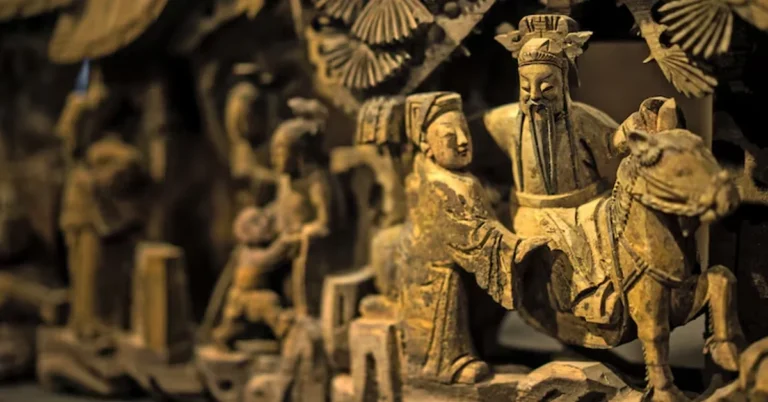The world of ancient civilizations holds an abundance of secrets waiting to be uncovered. Throughout the ages, art has been a crucial component of human expression, offering insights into the values, beliefs, and day-to-day lives of ancient societies. One such fascinating subject of exploration is the field of ancient arts—artz. From cave paintings to sculptures, pottery, and intricate carvings, these artifacts not only offer glimpses into the artistic talents of ancient cultures but also reveal profound connections to their spiritual, political, and social dynamics. In this article, we will dive deep into the fascinating world of ancient artz, examining their historical significance and uncovering the hidden stories they tell.
TRENDING
Exploring Chile Guajillo: Flavor, Benefits, And Cooking Tips
What Is Ancient Artz?
Ancient Artz refers to the various forms of artistic expression developed by ancient civilizations, spanning from prehistory to the fall of major ancient empires. These artistic forms include but are not limited to cave paintings, pottery, sculptures, textiles, jewelry, and architectural designs. Artz serves not only as a visual representation of the culture it originates from but also as a medium through which historical events, mythology, religion, and the daily lives of people are communicated.
The word “artz” itself is an ancient term that refers to artistic work—particularly those made before the establishment of written history. Artz, in its many forms, serves as a form of communication, encapsulating the ethos of the civilizations that created it. Each piece tells a story that has withstood the test of time.
The Importance Of Ancient Artz
Cultural Expression
Artz is a mirror to the values and ideas of ancient societies. It reflects the aesthetic preferences, religious beliefs, political ideologies, and social hierarchies that dominated at the time. For example, the grand monuments and sculptures of Ancient Egypt, such as the pyramids and the statues of pharaohs, were not just artistic creations but symbols of divine authority and eternal life.
Historical Records
Before the advent of written language, art was one of the primary means through which societies recorded their history. Cave paintings such as those found in Lascaux, France, provide a window into the lives of prehistoric humans, depicting animals, hunting scenes, and even spiritual symbols. These images serve as visual documentation, offering clues about the practices, environments, and rituals of early humans.
Technological Innovation
The creation of art in ancient times often required innovative techniques and tools. For example, the crafting of pottery in ancient civilizations like Greece and China involved advanced knowledge of materials, temperature control, and kiln construction. Similarly, the precision required to carve intricate statues in stone or mold bronze sculptures was not only a testament to the skill of the artisans but also the advancement of technology in ancient times.
Types Of Ancient Artz
Cave Art
One of the most significant forms of ancient art is cave painting, which dates back tens of thousands of years. Early humans used natural pigments to create images of animals, handprints, and abstract symbols on cave walls. These paintings are believed to have had ritualistic or symbolic significance, possibly relating to hunting magic or spiritual beliefs about the animals depicted.
Key Examples:
- Lascaux Caves (France)
- Altamira Cave (Spain)
- Chauvet Cave (France)
Sculpture
Sculpture is another prominent form of ancient art. From the exquisite statues of gods in Ancient Greece to the monumental stone carvings of the Mayans, sculpture was used to represent everything from deities and rulers to animals and abstract concepts. These sculptures often had symbolic meanings, such as conveying power, divinity, or societal values.
Key Examples:
- The Venus of Willendorf (Austria)
- The Pyramids of Giza (Egypt)
- The Moai statues of Easter Island (Chile)
Pottery
Ancient pottery is a testament to both artistic skill and technological advancement. Pottery was not only used for functional purposes like storage and cooking, but it also served as an art form in itself. Intricate designs, symbolic motifs, and painted scenes were common in ancient pottery, offering insights into the daily lives and beliefs of the people.
Key Examples:
- Minoan Pottery (Greece)
- Greek Black-Figure and Red-Figure Pottery
- Ancient Chinese Pottery (Terracotta Warriors)
Textiles And Weaving
Textiles were a vital aspect of ancient art. From the intricate weavings of the ancient Egyptians to the colorful tapestries of the Incas, textiles often depicted cultural stories, religious symbolism, or the status of the wearer. Ancient civilizations perfected the art of dyeing and weaving, creating complex patterns and vibrant fabrics.
Key Examples:
- The Shroud of Turin (Italy)
- Incan Textiles (Peru)
- Egyptian Linen Garments
Architecture
Ancient architecture often blended functional design with artistic creativity. The great pyramids of Egypt, the Roman aqueducts, and the temples of the Greeks are monumental examples of how architecture can both serve practical needs and act as artistic expressions. These structures are not only engineering feats but also carry deep symbolic significance.
Key Examples:
- The Parthenon (Greece)
- The Colosseum (Rome)
- The Ziggurats of Mesopotamia
The Influence Of Ancient Artz On Modern Art
The artistic achievements of ancient civilizations have had a profound influence on modern art. The classical ideals of beauty in Greek sculpture, the symmetry and precision of Roman architecture, and the intricate patterns found in ancient textiles continue to inspire contemporary artists. Moreover, ancient art serves as a foundation for understanding the evolution of artistic techniques, symbolism, and style.
Many modern artists, particularly during the Renaissance, looked back to ancient works for inspiration. The rediscovery of ancient Roman and Greek sculptures led to a revival of classical aesthetics, which was reflected in the paintings and sculptures of artists like Michelangelo and Leonardo da Vinci.
Preserving The Secrets Of Ancient Artz
While much of ancient art has been preserved, much of it has also been lost to time due to environmental factors, war, or natural disasters. However, modern technology, including digital imaging and preservation techniques, has allowed us to uncover and protect these valuable pieces of history. Ongoing archaeological excavations continue to reveal hidden artifacts, and museums worldwide are dedicated to preserving and showcasing these works of ancient art for future generations.
Conclusion
Ancient Artz is a fascinating journey through time that unveils not only the creative expressions of early human societies but also their deeper cultural, religious, and historical contexts. The rich diversity of ancient art—from the first cave paintings to the architectural wonders of antiquity—provides us with invaluable insights into the lives of those who came before us. As we continue to explore and preserve these ancient works, we unlock the stories of the past, ensuring that the legacies of ancient civilizations remain vibrant and relevant in our modern world.
ALSO READ: Discover The Power Of Hrdopce: Unlocking Its Full Potential
FAQs
What is Ancient Artz?
Ancient Artz refers to the various forms of artistic expression created by ancient civilizations, ranging from cave paintings to sculptures, pottery, and textiles. These artworks provide insight into the cultural, religious, and technological aspects of early societies.
Why is Ancient Artz important?
Ancient Artz is important because it serves as a historical record, documenting the values, beliefs, and practices of ancient civilizations. It allows us to understand their daily lives, social structures, and technological advancements.
What is the significance of cave paintings in ancient art?
Cave paintings, like those found in Lascaux and Altamira, are among the earliest forms of human expression. These paintings often depict animals and symbols, potentially related to hunting rituals or spiritual beliefs, offering us a glimpse into early human life.
How has Ancient Artz influenced modern art?
Ancient Artz, particularly Greek and Roman sculpture, architecture, and symbolism, heavily influenced the Renaissance and contemporary art. Modern artists often draw inspiration from the techniques and themes found in ancient works.
What materials were used in ancient art creation?
Ancient artists utilized a variety of materials depending on their environment and available resources. These included natural pigments for cave paintings, clay for pottery, marble and bronze for sculptures, and textiles like linen and wool for weaving.

